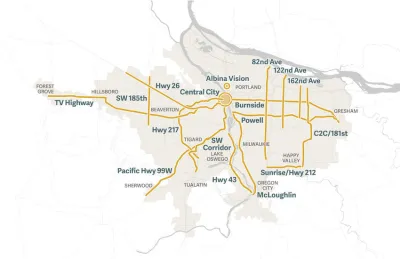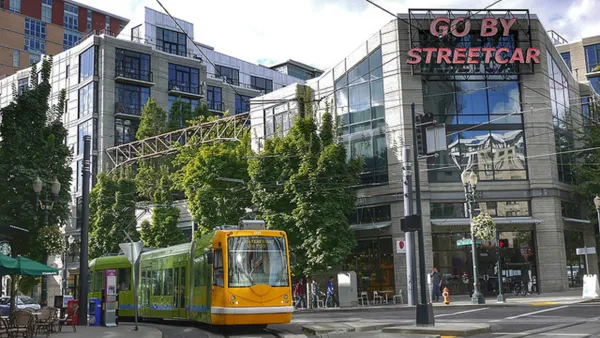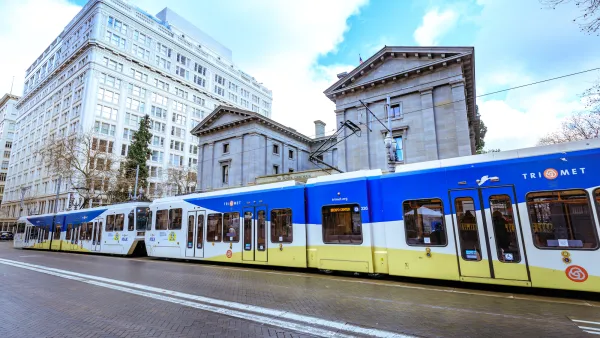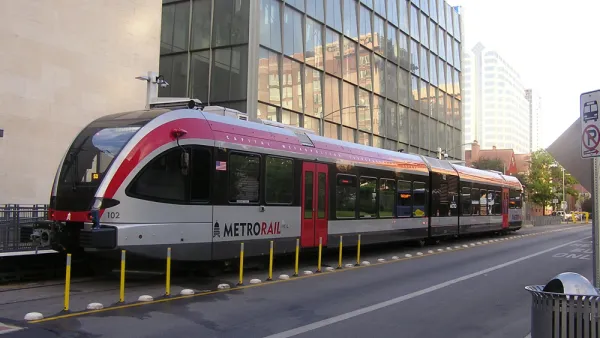The Get Moving 2020 transportation plan will face voters in thee Portland, Oregon region in November.

In July, the Metro Council, the regional planning organization for the Portland, Oregon area, finalized a historic ballot measure for consideration by voters in November. The "Get Moving 2020" plan requires voters to approve a $7 billion bond to fund safety, transit, and other transportation projects in Multnomah, Washington, and Clackamas counties.
"Among other investments, the measure would extend the MAX from downtown Portland to Tualatin, connect a regional rapid bus network, repair and replace bridges, complete sidewalks and pedestrian crossings on major roads, and upgrade thousands of traffic signals and streetlights," reported Chris McGinness back in July.
The bond would be financed with a new .75 percent payroll tax on businesses that the Metro Council claims will only apply to 10 percent of businesses in the region, with an exception for small businesses. That tax provoked opposition to the measure from the Portland Business Alliance, according to McGinnis.
The Metro Council has created a website to provide more information on the expenditure plan and governance of the proposed bond. Here's how that website summarizes the Get Moving 2020 plan:
If the proposed measure passes, 17 primary travel routes, known as corridors, are proposed for projects. Approximately 150 total projects are proposed in these corridors. If the measure passes, proposed corridor projects would include a light rail line in the Southwest Corridor between downtown Portland and Washington County, a rapid regional bus network, bridge replacement and repair, sidewalks and pedestrian crossings, off-street biking and walking facilities, and traffic signal and intersection upgrades.
The website includes additional projects and programs that will be funded by the Get Moving 2020 plan, like bus and MAX passes for youth, safe active transportation projects near schools, and the transition of buses from diesel to electric and low-carbon fuels.
FULL STORY: Metro sends historic bond to the November ballot

National Parks Layoffs Will Cause Communities to Lose Billions
Thousands of essential park workers were laid off this week, just before the busy spring break season.

Retro-silient?: America’s First “Eco-burb,” The Woodlands Turns 50
A master-planned community north of Houston offers lessons on green infrastructure and resilient design, but falls short of its founder’s lofty affordability and walkability goals.

Delivering for America Plan Will Downgrade Mail Service in at Least 49.5 Percent of Zip Codes
Republican and Democrat lawmakers criticize the plan for its disproportionate negative impact on rural communities.

Test News Post 1
This is a summary

Test News Headline 46
Test for the image on the front page.

Balancing Bombs and Butterflies: How the National Guard Protects a Rare Species
The National Guard at Fort Indiantown Gap uses GIS technology and land management strategies to balance military training with conservation efforts, ensuring the survival of the rare eastern regal fritillary butterfly.
Urban Design for Planners 1: Software Tools
This six-course series explores essential urban design concepts using open source software and equips planners with the tools they need to participate fully in the urban design process.
Planning for Universal Design
Learn the tools for implementing Universal Design in planning regulations.
EMC Planning Group, Inc.
Planetizen
Planetizen
Mpact (formerly Rail~Volution)
Great Falls Development Authority, Inc.
HUDs Office of Policy Development and Research
NYU Wagner Graduate School of Public Service





























